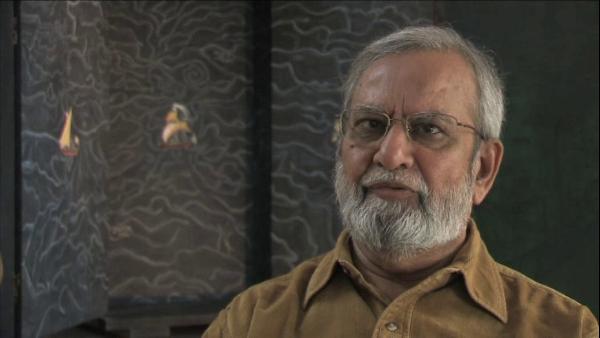NEXT STORY

Travelling Shrine – Home (Part 1)
RELATED STORIES

NEXT STORY

Travelling Shrine – Home (Part 1)
RELATED STORIES


|
Views | Duration | |
|---|---|---|---|
| 51. Figures in my work | 38 | 01:40 | |
| 52. The commission at Bhopal | 39 | 09:20 | |
| 53. Using computers for my work and mappa mundi | 61 | 09:43 | |
| 54. The story of books | 35 | 06:48 | |
| 55. The peepshow man | 26 | 03:43 | |
| 56. Travelling Shrine – Home (Part 1) | 39 | 07:01 | |
| 57. Travelling Shrine – Home (Part 2) | 30 | 09:07 | |
| 58. More about my family (Part 1) | 30 | 02:18 | |
| 59. More about my family (Part 2) | 30 | 06:29 | |
| 60. Differences between Surendranagar and my life now | 32 | 06:49 |


Well, I mean you are asking this question which takes me back to childhood, and the tradition continues. One would still find them in the fairs or the Melas, even in big cities sometimes, but you would find them in small towns. Well, this is a kind of a little box in which, if I if I'm right, I think they have a scroll of images, you know, and there is a little peeping kind of a, you know, a little hole with a glass. So it is a bit like looking into a camera, and then they would have, you know, they would roll it so the images come one after the other. So if children... I think sometimes there were two, and two children could see together, and the story is... something like ‘Dilli ka darbaar dekho’ they are called, you know, ‘Look at the court of Delhi, look at Taj Mahal, look at the Qutub Minar’. You know, they show you sights, and I think that memory still lingers somewhere. You know, it’s there. It is a kind of a precursor to this kind of, you know, magic lantern or magic tales, or in a way a magic box, in a way camera, and perhaps extended to computer, if one wants to do that, and you have the film, cinema, you know, all these things get connected. I remember, you know, I would even connect it with, you know, when I once put various images together, I sort of brought this ‘Speaking Tree’ together. In a strange sort of way, this kind of work sounds or appears like fantastic and disparate images. When they are put together, you know, when you even see the sights on the little magic box, and the tree which has various animals and mythical characters and others, this all seemed to sort of make sense, you know.
Didn’t you once say that the peepshow man had a cry in the street?
Well, peepshow man carried that thing on him, and he moved from street to street. You know, he would go and then, you know, children would gather with a few paisa, one paisa or so, you know, children would sort of go and look at these things. So that was a very early memory, yes, true.
Didn’t you say he said, ‘I will show you the world’?
I don’t know. I think generally what we know, it can be, you know, it would be. ‘Duniya dekho’ they call that means, you know, I show you the world, you know. So he would cook up, and he would in fact sing and show you, you know, this thing while he was rotating these images. It was a kind of a real magic, magic lantern, you know, where the world came to you.
Gulammohammed Sheikh is an Indian painter, writer and art critic who has been a major figure in the Indian art world for half a century. His artistic career is closely associated with the renowned MS University of Baroda in Gujarat where after gaining his Master's degree, Sheikh went on to teach in the Faculty of Fine Arts, and where he was appointed Professor of Painting in 1982.
Title: The peepshow man
Listeners: Timothy Hyman
Timothy Hyman is a graduate of Slade School of Fine Art, London, in which he has also taught. In 1980 and 1982, he was Visiting Professor in Baroda, India. Timothy Hyman has curated many significant art exhibitions and has published articles and monographs on both European and Indian artists.
Duration: 3 minutes, 43 seconds
Date story recorded: December 2008
Date story went live: 18 November 2010